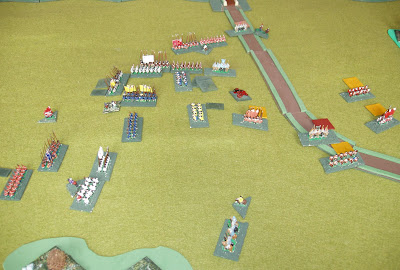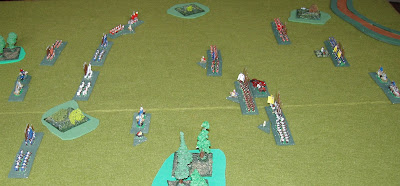Although the flow of blog posts has been fairly uninterrupted, there has been a behind the scenes hiatus in wargaming here at Castle Polemarch. The reasons are mostly too dull to go into, except to mention that one of them has to do with rebasing the Aztecs. This project is nearly complete, but I am still wondering whether it is worth rebasing the Inca, as well. I am not sure; I think the Inca have only been on the table once in their career.
Still, existential angst aside, I did, on an insanely hot day in June, while the final batch of Aztec bases were drying, I undertook the next move in the War of Stuart Succession. Mostly, the sides took to diplomacy, without too much happening in the outcomes. James VI’s armies, however, advanced, which brought his western army to the border with England, and his eastern army, commanded by himself, to the North Riding of Yorkshire. There, James failed his GOOS roll, and the trained bands were called out against him.
The map showed that the Spanish, under Isabella, were actually in Hull, also known as the East Riding, next door. A little dice rolling saw them offer support to the trained bands, but a failed GOOS roll meant that the Yorkshire lads decided to tough it out for themselves. The Spanish therefore, stayed in Hull, awaiting the outcome.
The setup is above, the Scots to the left. The Scottish light horse is deployed at the end of a hill, as are the English in the right foreground and those in the enclosure on the far side. I suppose that, sometime, I should get around to making fields and hedges and stone walls which actually fit together, but my rationale is that the enclosures are a set of small fields, with lots of hedges or walls, rather than neat super fields as we have today. That’s my excuse, anyway.
The English plan was simply to stay on the defensive across the line, relying on their infantry superiority and positions on hills. The cavalry (they rolled 2 demi-lancers) was to plug any gaps. James pondered his plan deeply, and decided to direct two infantry formations (he gave up on doubled formations after last time) to assault the hill on his right (nearest the camera) while everyone else kept the English entertained in the centre and on the left.
The picture shows how the plan evolved. The Scottish light horse have had some nasty encounters with English musketry and are more or less out of the game at present. On the far side, the Scottish advance has somewhat stalled, again due to straight shooting from the English side. In the foreground, however, the Scots are arriving in numbers. While the English position on the hill is quite strong, it is not clear that it is strong enough to stave off a 2:1 assault.
It just goes to show how wrong I can be, I think. Above, you can see that the Scottish centre and left have stalled against the English. But James’ plan always included the flank attack. Well, that did not proceed as well as the King hoped, shall we say. The English got the drop on the Scots and attacked downhill. The English pike saw off the Scottish musketeers while the English musketeers gave a severe fright to the Scottish pike.
A bit of a swirling infantry combat ensued. The English musketeers were then flanked by their Scottish brethren and lost, being removed from the fight. However, the English pike flanked their already shaken Scottish cousins and caused them to flee, before turning to attack the Scottish musketeers still recovering from their fight, and routing them. See? I said it was swirling.
The combat in the centre and on the Scottish left has more or less settled down into a long-range musket duel, which the Scots were, in my estimation, most likely to come off second best. After all, some of the English are behind stone walls, which makes them fairly invulnerable.
The above slightly fuzzy image shows the end of the game. The Scots are still stalled in their centre and on the left, but have now lost three out of four bases on their right, due to the heroics of the two English bases, of which only the pike remains. Having now lost another base, James had to make an army morale roll. In keeping with quite a lot of his rolling on the day, this went badly, meaning that his army morale slumped to 1, and the whole lot withdrew.
Well, that is another blow to James’s hope of obtaining the English crown. I have to admit that I was not sure about the Yorkshire lads' ability to beat the Scots. Not due to any misplaced admiration for the Scots, but simply because of the disparity of cavalry. As it happened, the musketry nullified the Scottish light cavalry, and the demi-lancers (on both sides) never got into the action. The terrain rolling gave the English some nice hills to hide up, however, although the defeat of the Scottish flank attack was not in the script at all. It should have worked!
As James’ army did not rout but withdrew from the battlefield, it is still extant, and so Isabella’s army in the East Riding will need to keep an eye on it. There is also the question of what happens when the western army crosses into England. James’ GOOS score is now so low that it is likely they will have some tough fights going south.
In other news, the Dutch have raised a new navy, although to what end no one knows. And in the south, there is three way diplomacy going on between Isabella, Arbella, and Edward Seymour. None of them seems to be willing to make concessions, nor to come to some agreement about the throne. There could be more to come on that. If Arbella weds Edward, she will forego her very good GOOS score, and Edward’s is much lower. Isabella, on the other hand, already holds London and is starting to boss the English armed forces around.
I wonder what will happen next….



























